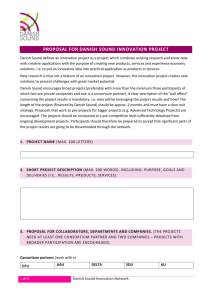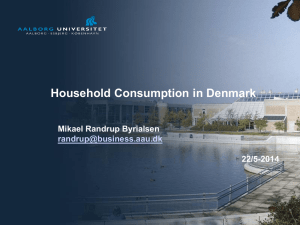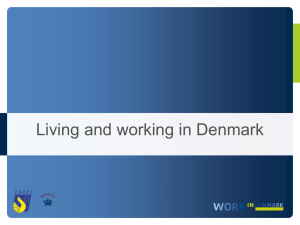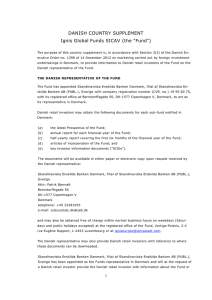The Energy Savings Insurance instrument 节能保险工具
advertisement
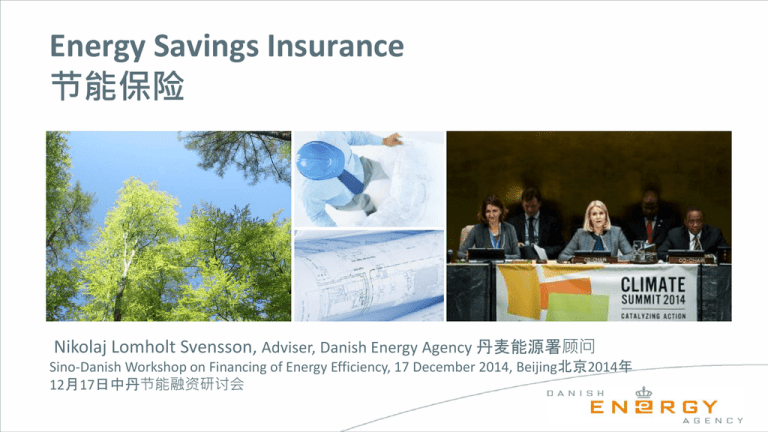
Energy Savings Insurance 节能保险 Nikolaj Lomholt Svensson, Adviser, Danish Energy Agency 丹麦能源署顾问 Sino-Danish Workshop on Financing of Energy Efficiency, 17 December 2014, Beijing北京2014年 12月17日中丹节能融资研讨会 Content 内容 1. Energy efficiency as a priority 能效是重点 2. Danish experiences 丹麦的经验 3. The Energy Savings Insurance instrument节能保险 工具 4. Road map for scaling up & Key cases 扩大规模的路 线图以及重点案例 5. Perspectives for China对于中国的启发 Content 内容 1. Energy efficiency as a priority 能效是重点 2. Danish experiences 丹麦的经验 3. The Energy Savings Insurance instrument 节能保险 工具 4. Road map for scaling up & Key cases 扩大规模的路 线图以及重点案例 5. Perspectives for China 对于中国的启发 Focusing on China makes sense 聚焦于中国是明智的 • • • • Energy use in China have accelerated relative to GDP since 1970s through to the 2000s with the boom of energy-intensive manufacturing. 从1970年以来到2000年, 伴随着能量密集的制造业的蓬勃发展, 中国的能源使用占GDP 比例也加速增长。 Changing this path will be critical for CO2-emissions to peak before 2030. 改变这一路径对于实现温室气体排放在2030年之前实现峰值非常关键 Energi efficiency potential pre-2020 2020前能效的潜力 • • • • Targeted energy efficiency measures would reduce global energy-related emissions by 1.5 Gt in 2020; a level close to that of Russia today. 有的放矢的能效措施能够到2020年减少1.5Gt全球能源相关的排放; 与目前俄罗斯的水平类似。 Most of the cost-effective potential is in buildings and industry. 大部分的成本有效性的潜力是在楼宇节能与产业。 Significant savings potential remains untapped 显著的节能潜力有待开发 • • • • • • • • In IEA’s 4-for-2 °C Scenario, China achieves 40% of the global emissions reduction related to more efficient heating and cooling systems. 在国际能源署的4类措施达成2摄氏度控温目标中, 中国通 过提更高供热及冷却系统的能效能够实现全球减排量40%。 The high share reflects the expected rapid increase in projected demand in China for such services, particularly for airconditioning. 高份额反映了中国此类服务预期迅速的需求增长, 特别是 空调。 Industry in China currently accounts for about two-thirds of the country’s total electricity consumption. 中国的产业目前占全国总耗电量的大约2/3. IEA estimates that 60-70% is used by electric motors with a vast savings potential; e.g. proper sizing and optimizing of motor-driven equipment. 国际能源署估计, 60%到70%的电机都具有巨大的节能空间, 如, 更合理的 Multiple benefits of energy efficiency 提高能效的多重好处 • • • • • • • • Investments in energy efficiency are expected to quadruple to USD 550 billion by 2035. 能效方面的投资预期到2035年增长四倍, 达到5500亿美元 Incorporating co-benefits into business and government planning reduces the payback period significantly. 将能效的伴生好处吸收到企业和政府的计划中能够显著缩 短回报期 The value of productivity and operational benefits can be up to 2.5 times (250%) the value of energy savings (ACEEE). 生产力和运营好处的价值能够提升到节能值的2.5倍(250%) (美国能效经济理事会) In China, the health costs associated with outdoor air pollution in urban areas has been estimated to USD 25-83 billion in 2003 and it has since intensified (World Bank). 在中国,城市地区 户外空气污染所引发的健康成本2003年 估计价值250-830亿美元, 而且自2003年以来逐渐加剧。 (世界银行) Content 内容 1. Energy efficiency as a priority 能效是重点 2. Danish experiences 丹麦的经验 3. The Energy Savings Insurance instrument节能保险 工具 4. Road map for scaling up & Key cases 规模扩大的路 线图以及重点案例 5. Perspectives for China 对于中国的启发 Main energy efficiency measures in Denmark 丹麦的主要能效措施 Incentives to reduce consumption 减少消费的激励措施 • Taxes on energy and CO2; packages in 1993 & 1996 • 能源以及Co2税费; 1993年以及1996年的套餐 Regulation 法规 • Standards, norms, etc. • 标准, 规定等 • Especially buildings and products, cars etc. • 特别是建筑和产品, 汽车等 Information, campaigns, etc. 信息, 宣传等 • Both to end-users and to installers, etc • 面对最终用户以及面对安装方的 Help to implement savings 帮助节能实现 • Subsidies, obligations etc. 补贴, 责任等 • Especially existing buildings and private enterprises 特别是现有的建 筑和私营企业 • Strong focus on industry 特别注重工业 Decrease in intensity减少强度: 1975-2012: 1,5 % p.a. 1994-2012: 2,1 % p.a. Energy savings obligation scheme for distributers 配电部门节能责任机制 Help to implementation is important 帮助执行很重要 • Savings in existing buildings and industry are complicated 在现有的楼宇以及工业中的节能很复杂 • Close to the consumers and cover all part of a country • 接近消费者并覆盖全国 A secure and stable way to finance energy savings activities 一个安全稳定的方式为节能活动融资 • Secures annual savings for each sector • 为每个部门获得年度节省 • Difficult to get money over the state budget • 很难从政府预算中拿到钱 Transformation of the utilities to energy service providers and consultants 将公用事业转化成能源服务提供者以及能源服 务咨询公司 • • Deliver the consumers need for energy services in the cheapest way 为消费者提供最便宜的能源服务 Weightings by sectors 2006-2012 2006到2012年不同部门的权 重 Danish industry among the Most Efficient 丹麦工业是能效最高的工业之一 • • • Denmark is more energy-efficient than most advanced economies. 丹麦比大部分发达经济都具有更高的能效 The energy intensity of Chinese industry has declined from four times the global average in 1990 to slightly more than two times today • 中国工业的能源强度已经从1990年代的世界平均水平的4倍降到目前世界平均水平的2倍. Energy efficiency improves Danish competitiveness 能效提高了丹麦的竞争力 • High energy prices have relatively small impact on producer prices in Denmark due to the high energy efficiency of Danish production. 由于丹麦生产中的高能效, 高企的能源价格对于丹麦的生产商价格影响较小 • Denmark’s competitiveness improves when energy prices rise. 丹麦的竞争力也随着能源价格的增长 而提高。 Significant export of Danish energy technologies 丹麦能源技术的显著出口 • • Political decisions to promote sustainable energy solutions creates business opportunities. 政治上的决定, 提升可持续能源解决方案, 创造商业机会 • • Danish exports of energy technology to China totaling 2.2 billion DKK in 2012. 丹麦2012年向中国出口金额为22亿丹麦克朗的能源技术 Content内容 1. Energy efficiency as a priority能效是重点 2. Danish experiences 丹麦的经验 3. The Energy Savings Insurance instrument 节能保 险工具 4. Road map for scaling up & Key cases规模扩大的路 线图以及重点案例 5. Perspectives for China对于中国的启发 Energy Savings Insurance: Objective & Purpose 节能保险: 目标以及目的 Key barrier 主要障碍 • Local Financial Institutions (LFIs) assign little or no value to cash flow generated by expected energy savings and EE equipment, thus encumbering borrowing capacity • 本地金融机构(LFI) 对于节能或者提高能效设备所预期产生的现金流只估为很少的金额, 阻碍了借贷的 水平。 • Instrument seeks to overcome this barrier • 克服这一障碍的工具 • Ensure dependable financial flows from future energy savings 保证未来节能产生的可靠的财务流 • Develop a business model in which an “insurance component” underwrites minimum savings estimated for specifically defined energy efficiency measures 打造业务模型, 其中包含“保险部分”, 承保特别定义的提高能效措施估计产生的最少节能 • Countries where ESCOs are not “fully-fledged” and don’t have financing capacity could particularly benefit from the instrument 那 些能源服务公司还没有发展“完全成熟” 的国家, 以及没有融资能力的国家可以从这个工具中受益 Concept Development: “Off the Shelf Business Model” that can be adapted for different markets 概念发展: “现成的商业模型” 可适用于不同的市场 The instrument must address several key challenges on various levels 这一工具必须在不同层面解决几个主要的挑战 • Technical: Independent assurances to support implementation and provide warranties • 技术: 独立担保, 支持实施并提供保障。. • Legal: Contractual arrangements between clients and service providers need to be transparent and standardized • 法律: 客户和服务提供者之间的合约安排需要透明标准 • Insurance: Compensation / insurance schemes in case promised financial flows associated with EE savings do not occur. • 保险:如果能效提高节能带来的财务流没能实现,这种情况下的 补偿/保险机制 • Standards: A reliable system depends on clear standards for monitoring and verifying energy savings. • 标准: 一个可靠的系统依赖于监管以及核实节能量的清晰标准 • Risk-sharing: An integrated approach must ensure risks & obligations are placed where they can best handled. • 风险分担:一体化的措施必须保证风险以及责任分配到有能力承担的方面去。 Part of a ”risk management package” 风险管理包的一部分 Insurance component is not a stand-alone solution 保险部分不是一个独立的解决方案 • Must be developed as an integrated element of a package providing a pipeline of projects • 应该作为一个风险管理包中的一部分开发, 可提供给一系 列项目 • Identify a market for energy efficiency equipment and services 确认能效设备和服务的市场 • Encourage a new class of equipment and service providers to address that market • 鼓励新级别的设备和服务提供商进入这个市场。 • Invent a certification process for the companies and means to vet their projects • 为公司开发认证流程, 以及筛选项目的方法 Energy Savings Insurance: The Business Model 节能保险: 商业模型 Diminishing donor involvement 减少捐赠方的参与 • • • • • • Energy Savings Insurance aims to boosts investor confidence in the financial viability of larger-scale energy investments. 节能保险致力于提升投资方在大型能源投资财务可行性上的信心。 Donors can initially subsidize market studies, validation of projects etc. to help build an early pipeline of demonstration projects and attract commercial banks and insurers. 捐赠方可为初始的市场研究, 项目确认等提供补贴, 以帮助建立一系列示范性的项目, 并吸引商业银行和保险公司的参与。 Banks will eventually assume technology risks. 银行最终承担技术风险。 Blocks of activities in an implementation plan 执行计划中的活动单元 Content内容 1. Energy efficiency as a priority能效是重点 2. Danish experiences 丹麦的经验 3. The Energy Savings Insurance instrument 节能保险 工具 4. Road map for scaling up & Key cases 扩大规模的 路线图以及重点案例 5. Perspectives for China来自中国的启发 Road map for scaling up Energy Savings Insurance 扩大节能保险规模的路线图 Proof of concept: piloting in Mexican agro-industry 概念验证: 在墨西哥农业的试点 Importance of piloting 试点的重要性 • Provides “proof of concept”. 提供“概念的验证” • Utilizes UNSG Climate Summit to gather support. 利用联合国秘书长气候峰会征集支 持。 • Feeds into Global Innovation Lab for Climate Finance. 试点成果贡献到气候金融全球 创新实验室。 Relevance in Mexico 墨西哥的相关性 • Strong learning points from IDB’s energy savings program in Columbia with state-owned commercial bank Balcoldex. 可以从联合国工发组织在哥伦比亚与国有商业银行 Balcoldex合作的节能项目上学习很多经验 • High potential market for EE financing but despite financial attractiveness many projects are not financed due to barriers of knowledge, perceived risks and liquidity. 对于能效融 资的巨大市场潜力, 然而, 尽管很多项目具有财务优势, 他们由于种种限制, 如 Regional Energy Savings Insurance facility in Latin America 拉丁美洲的地区性节能保险工具 IDB’s new platform engages 5-6 sectors in multiple countries 联合国工发组织的新平台吸引了多个国家, 5-6个部门参与 Market studies to access the energy efficiency potential and market opportunities to inform sector and technology focus. 市场研究能效的潜力, 以及市场的机会, 以通报部门及技术的重点。 • Access local energy efficiency value chain and ESCO industry. • 参与到本地能效价值链中以及能源服务公司产业中来。 • Identify suitable implementing institution (”champion”) with mandate and capacity to structure and implement program. • 确认合适的执行机构(冠军), 授予他们授权, 以及能力以建构并执行项目。 • Identify and engage local and international finance institutions. • 确认并与本地以及国际金融组织接触 • Access the regulatory/policy framework in order to identify enablers and major barriers. 接触监管/政策框架, 以确认能动方以及主要障碍 • Develop and implement a tailored intervention package along the lines of the pilot initiatives with a complete risk mitigations package; including Energy Savings Insurance. 开发并执行个性化的干预措施, 符合试点的倡议, 并具备全面完整的风险减轻措 施; 包括节能保险 IFC Energy Performance Insurance (EPI) 国际金融公司能源绩效保险(EPI) • • • EPI is an insurance which a service provider or end-beneficiary can procure to hedge against underperformance of energy efficiency installations. If the expected energy savings are not realized, the insurer compensates the end-beneficiary for the insured shortfall. 服务提供方或者最终受益者可购买EPI保险,以对冲节能设备安装后绩效低于预期的情况。 如果预期的节能没能实现, 保 险公司将承保的不足部分赔偿给最终受益方。 Efficient HVACs (heating, ventilating, and air conditioning), Intelligent Controls and Variable Speed Drives identified as key technologies in China . 确认中国的重点技术是高效的暖通空调, 智能控制以及变速驱动器 Assets资产 Potential Losses潜在损失 Portfolio of policies on insurer’s Balance Sheet保险公司资产负债表Insurance Company 的保单组合 保险公司 (Energy Efficiency Projects) (能效 项目) IFC Senior Risk 高级风险 First Loss 第一损失(由捐 献方提供) (provided by Donors) Content内容 1. Energy efficiency as a priority 能效是重点 2. Danish experiences 丹麦的经验 3. The Energy Savings Insurance instrument节能保险 工具 4. Road map for scaling up & Key cases扩大规模的路 线图以及重点案例 5. Perspectives for China 对于中国的启发 Questions for consideration 思考的问题 • Is Energy Savings Insurance a feasible instrument in Chinese context? Or is the ESCO market already well-developed and mature? 节能保险在中国的环境下是可行的工具么? 还是需要一个节能服务公司已经非常发达成熟的市场环境? • If feasible, which sector(s) would be most relevant for pilot program(s) to focus on? Which enterprise sizes would be most relevant to focus on, e.g. small-medium vs. large? • 如可行, 哪些部门可以作为试点项目重点开展: 什么样的企业规模可以是重点开展的对象? 如,中小企业还是大型企业? • How could such a program be designed so that it adds value to existing and/or planned energy efficiency policies in China? • 这样的项目应该如何设计, 才能为现有的和/或中国的能效政策计划增加价值? • Which government agencies and regulators should to be involved? • 哪些政府部门和监管机构应该参与 • Who could lift key the roles as implementing institutions and insurers etc.?谁决定执行机构和保险公司的角色? Thank you! Contact 联系方式: Nikolaj Lomholt Svensson, Adviser, Danish Energy Agency 丹麦能源署顾问 E-mail: nls@ens.dk Tel.no.: +45-41339478


